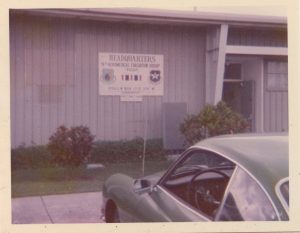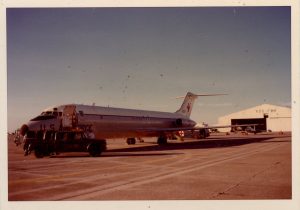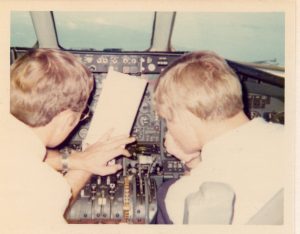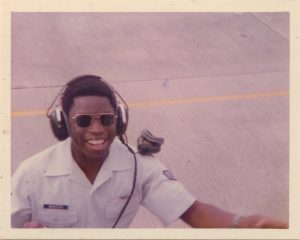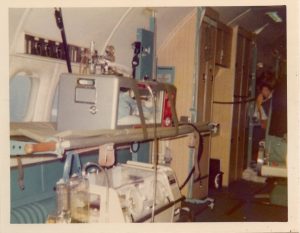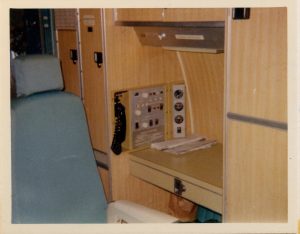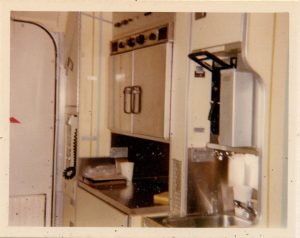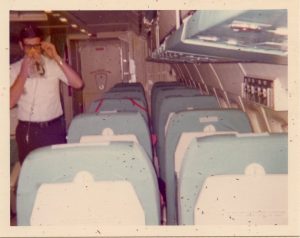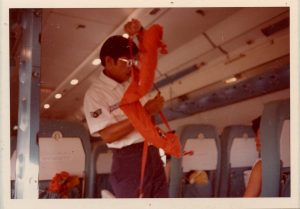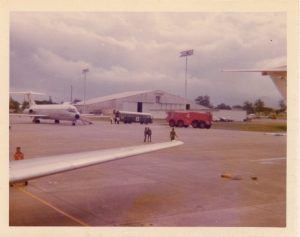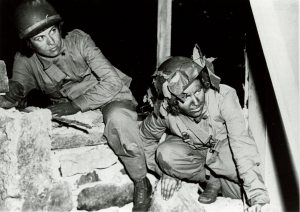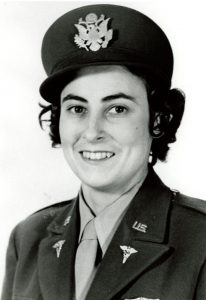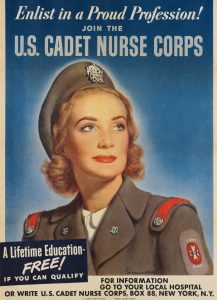USAF Flight Nurse Photo Album
When stationed as a flight nurse with the 9th Aeromedical Evacuation Group at Clark Air Base, Philippines, 1973–75, I put together a hand-printed photo album illustrating a “typical” day of air evac duty. The photos, all but one of which I took myself, were taken on several different missions in 1975 and do not represent an actual flight plan.
In this typed version of the original text, which I printed in block capitals, I have divided the content into three sections across three blogs: PRE-FLIGHT, INFLIGHT, and POST-FLIGHT. Page numbers refer to the original photo album.
Page 1
PRE-FLIGHT
ME IN LITTER RAMP DOORWAY OF C-9A ON FLIGHT LINE AT CLARK AIR BASE
“GOOD MORNING LADIES AND GENTLEMEN AND WELCOME ABOARD THE C-9A. YOUR AIRCRAFT COMMANDER TODAY IS ____, AND I AM CAPT BARGER, YOUR MEDICAL CREW DIRECTOR …. “
Page 2
The phone in my room rings at 0430. “Good morning, Capt Barger. I’m alerting you for your flight today.”
MY CAR AT THE SQUADRON BUILDING
The Air Evac Control Center at 9th Group is where patients are called in for movement on a routine [scheduled] or alert [unscheduled, but urgent to save life, limb, or eyesight] mission and where air evac missions are planned, coordinated, and monitored. This is where the day begins.
Page 3
The C-9A Nightingale, produced by McDonnell Douglas Aircraft Corporation, is the military version of the commercial DC-9. There are 4 C-9A’s at Clark, and these aircraft cover an 85-million square mile area and fly into some 260 airfields in 9 different countries. The C-9A cruises at 500 mph at an altitude of around 30,000 feet. The C-9A is capable of carrying a total of 40 ambulatory patients, 40 litter patients, or a combination of both. Each routine mission carries a medical crew of 2 nurses and 3 medical technicians. An alert mission carries 1 nurse and 2 med techs. Our routine missions take us to airfields in the Philippines, Taiwan, Okinawa, Korea, Japan, Thailand, and Vietnam.
C-9A ON FLIGHT LINE AT CLARK AIR BASE
Page 4
The basic flight crew on the C-9A includes the pilot, the co-pilot, and the flight mechanic. Here Lt Johnson, pilot, explains something to the co-pilot, Lt Gray.
PILOT AND COPILOT IN C-9A COCKPIT
SSgt Winstead, a flight mechanic, has just given the pilots the go-ahead to start engines. He’s now boarding the C-9A prior to take-off. The flight mechanic is also responsible for refueling the C-9A.
FLIGHT MECHANIC SSGT WINSTEAD WALKING ONTO THE C-9A
Page 5
Please join me on a grand tour of the cabin of the C-9A. As you walk onto the aircraft through the forward entrance door and face aft [to the rear], to your left is the special care area. This is our intensive care unit, where we put our sickest patients. It also can be used for isolation patients. Special features of the special care area include ultraviolet lights and exhaust fan to kill micro-organisms and control odors, a curtain to close off the area, 3 lights with self-coiling extension cords that clip onto the litter to facilitate patient care, extra oxygen and suction outlets and 60-cycle and 28V DC electrical outlets, and dim-to-bright ceiling lights.
In this picture, Kenneth, 5 weeks old, is in the top incubator; the bottom incubator is being returned to Clark for maintenance. The medical crew director (MCD) of the mission is giving the cruise briefing: “LADIES AND GENTLEMEN, OUR NEXT STOP WILL BE FUKUOKA, JAPAN, AND OUR ENROUTE TIME WILL BE ….”
Page 6
Across from the special care area is the medical service area.
MEDICAL SERVICE AREA
This area includes a foot-operated scrub sink with liquid soap dispenser, and a medicine cabinet complete with stock drugs. In the top cabinet are IV tubing and blood recipient sets. In the blue cabinet are IV solutions, IV tray, and distilled water, and in the drawers below are needles and syringes. Cabinets below store medical supplies — OB packs, disposable masks, bedpans, catheterization kit, and irrigation tray.
Aft of the special care area is the medical crew director (MCD) station.
The MCD station consists of a writing desk and lamp, a communications and light-control panel, and temperature, therapeutic oxygen, and vacuum system gauges, a medical records drawer, bookshelf, and storage area for more medical supplies — oxygen masks, emergency drugs, suction catheters, bite-sticks, bulb syringe, and dressing supplies.
Page 7
Aft of the litter ramp door is the central storage compartment.
CENTRAL STORAGE COMPARTMENT
This area provides storage space for linens, Ambu bag [trademark name of resuscitator bag for artificial respiration], Bird respirator [trademark name for mechanical ventilator], and miscellaneous supplies. The orange bundles you can see underneath are 2 of the 3 20-man life rafts that we carry on all missions.
This picture shows the main cabin area, configured on this trip to accommodate 38 ambulatory patients. All patient seats face aft. That’s Sgt Novicio, the senior med tech, sitting in his crew seat, which is attached to the aft door in the tail section.
MAIN CABIN AREA
Page 8
In the tail section of the cabin is the aft galley.
AFT GALLEY
The forward galley just aft of the cockpit has a medical refrigerator. The aft galley is used to prepare patient meals. Here are found the refrigerator and freezer, the oven that can cook 24 meals in about 30 minutes time, the coffee maker, and sink. The aft galley is the only place on the C-9A where one can get ice-cold or boiling-hot water. Just forward of the door is the senior tech’s control panel where he can make PA announcements, speak with the MCD or pilot via intercom, and turn cabin lights on and off. The MCD gives the pre-departure briefings; the senior tech gives the descent briefings.
Page 9
“… IF FOR ANY REASON THERE IS A MALFUNCTION IN CABIN PRESSURIZATION, COMPARTMENTS ABOVE EACH SEAT OR LITTER WILL AUTOMATICALLY OPEN, PRESENTING AN OXYGEN MASK. IMMEDIATELY EXTINGUISH YOUR CIGARETTE AND PULL THE MASK TO YOUR FACE, PLACE OVER YOUR NOSE AND MOUTH, AS DEMONSTRATED BY SSGT EVERINGHAM, AND BREATHE NORMALLY …”
SSGT EVERINGHAM DEMONSTRATES USE OF OXYGEN MASK
“… SGT NOVICIO WILL NOW DEMONSTRATE THE USE OF THE LIFE VEST. ON ONE SIDE OF THE VEST ARE INSTRUCTIONS TO PLACE THAT SIDE TOWARD YOUR BODY. DON THE VEST IN THE SAME MANNER AS A JACKET …”
SGT NOVICIO DEMONSTRATES USE OF LIFE VEST
Page 10
The blue ambus [ambulance-bus] brought the patients to the flight line. The fire truck stands by.
AMBUS AND FIRE TRUCK WAIT NEAR C-9A
Flight mechanic SSgt Knight is monitoring the start of engines for takeoff from Clark. We’re deploying to escape a typhoon on this day. That’s our squadron building in the background.
SSGT KNIGHT MONITORS START OF ENGINES
To be continued.


